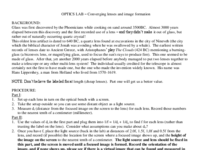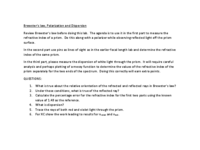Lab Exercises - Thin Lenses, Brewster's Law
Focal Length Lab
The first agenda is to find the focal lengths of two reflecting surfaces (convex and concave) and of two lenses (converging and diverging) in a ray optics kit.
While it's obviously common to use light sources to find focal lengths, we will rather use lines of sight constructed using pairs of pins placed into a foam board. Each pair will constitute a light ray. Two pins can represent an incoming or outgoing ray. You need two rays going in and two going out in order to find a place where they meet. That point is the focal point so long as the incoming "rays" are parallel.
Q1: What is the focal length in cm of the convex mirrored surface?
Q2: What is the focal length in cm of the concave mirrored surface?
Q3: What is the focal length in cm of the converging lens?
Q4: What is the focal length in cm of the diverging lens?
Q5: In which of the four systems is a real image possible.
Please submit your drawings with measurements labeled along with the lab.
Thin Lens Equation Lab
The goal of this experiment is to verify the thin lens equation, or that . We will do this for both a converging and a diverging lens.

